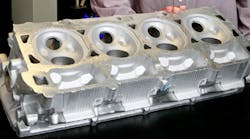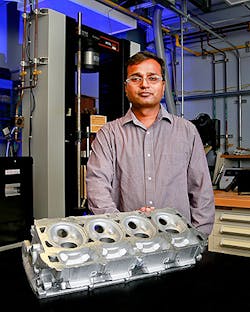In the automotive industry, everything is up for reconsideration, as designers and manufacturers look for new materials, concepts, and production technologies that might address the never-ending demand to make cars and trucks more fuel-efficient and more environmentally tolerable, to list just the most obvious objectives. Inevitably, these efforts at improvement lead back to the drawing board, or laboratory, as the case may be, and frequently those lab projects involve metalcasting research.
The Lightweight Innovations for Tomorrow program, an initiative traced to the U.S. Department of Defense, has two metalcasters research projects underway: one involving Michigan Technological University and Grede Holdings’ St. Cloud, MN, foundry, is refining techniques for casting lightweight automotive transmission cases in iron alloys.
Another LIFT project involves the Ohio State University College of Engineering metalcasting research program developing vacuum-aided aluminum diecasting technologies, to define parameters for producing parts that are thinner than standard but denser and thus stronger because of the absence of air pockets.
Now, the Department of Energy’s Oak Ridge National Laboratory is conducting research to define new aluminum alloys for automotive powertrain castings, driving toward the
Environmental Protection Agency’s new CAFÉ standards that demand passenger vehicles achieve an average of 54.5 mpg fuel efficiency by 2025. The Big Three domestic automakers are working with the national labs on various development programs, with the ORNL project involving FCA US LLC and Nemak, the automotive foundry group based in Monterrey, Mexico.
Powertrain parts must get lighter to meet that 2025 goal, but the industrial requirements also call for materials that will endure high temperature cycles and the pressures inherent to high-efficiency turbocharged engines that are in consideration. Of course, the selected material must be affordable, for the automakers and the vehicle buyers. According to the researchers, the development time for this project will have to outpace the ordinary cycle for new materials, 10 to 20 years in some cases.
ORNL is leading the research on behalf of DOE’s Vehicle Technologies Office, which is coordinating the efforts by national laboratories, universities and the metalcasters to develop high-strength aluminum alloy that is capable of operating reliably at up to 300°C – and yet maintain affordability.
Their target is a material that will be 25% stronger than current aluminum alloys and durable at temperatures 50°C higher. “The aggressive goals of these projects compress about half a century of typical materials development into a four-year project,” stated DOE program manager Jerry Gibbs.
Researchers from ORNL, FCA US, and Nemak are using integrated computational materials engineering (ICME) to speed up development of new high-temp aluminum alloys for automotive cylinder heads. ICME makes it possible to customize new alloys at the atomic level according to targeted properties.
“Aluminum has been in mass scale production for more than a century, but current cast aluminum alloys cannot withstand the temperatures required by new advanced combustion regimes,” explained Amit Shyam, the ORNL principal investigator. “Our goal is to take high-temperature cast aluminum where it has never been.”
One particularly notable detail of the research involves scaling ICME to run on DOE’s Titan supercomputer, the second fastest computer in the world. That system’s speed and parallel processing power allows ORNL researchers to model new alloys and select only the likeliest possibilities for further experimentation. This predictive capability reduces dramatically the time, energy, and resources devoted to casting trials.
“Using approximately 100,000 cores simultaneously on Titan, we can increase the speed and scale of our first-principles quantum mechanics calculations by at least an order of magnitude,” according to Dongwon Shin, another ORNL researcher.
Previous to the supercomputer calculations, Shin was using a Linux cluster with approximately 300 cores to create atomistic simulations of individual elements diffusing to intermetallic precipitates within the prospective alloys. On Titan, the researchers can achieve larger scale simulations that are nearer to real-world scenarios.
The team also is using atomic scale imaging and analytical chemistry measurements to verify the computational models. Scanning transmission electron microscopy and atom probe tomography allow the Oak Ridge researchers to identify and examine the location and chemistry of each atom in the alloy matrix, precipitates, and the interfaces between them.
From their discoveries, ORNL, FCA US, and Nemak are creating a database of their aluminum alloy materials. This approach (described as a “materials genome”) will guide the efforts to improve ICME capabilities and accelerate the new materials development.
In a different laboratory setting, Brunel University in London is in line to host one of two £10-million (est. $15 million) manufacturing research hubs, to study ways to optimize the industrial materials recycling sequence, to maximize the value materials extraction and energy consumption in metalcasting and related industrial processes. The primary funding will come from Britain’s Engineering and Physical Sciences Research Council, and other universities will support the research, and over £45 million (est. $70 million) pledged by industrial partners.
They intend for the Future Liquid Metal Engineering Hub to address the long-term challenge of rising energy and materials costs for U.K. manufacturing, initially for British automakers and their suppliers, and then the wider transport industry. The Hub will seek to shorten the time for technology development to application, advance new competitive technology, reduce the cost of “recycling-friendly advanced metallic materials”, and reduce CO2 emissions.
“Further economic impact (£800 million/est. $1.2 billion annually) will be through retaining and recycling aluminum scrap into high-value automotive castings, extrusions and sheet for lightweight vehicles,” the according to the program’s announcement.










